
The southern platyfish, common platy, or moonfish is a species of freshwater fish in family Poeciliidae of order Cyprinodontiformes. A live-bearer, it is closely related to the green swordtail and can interbreed with it. It is native to an area of North and Central America stretching from Veracruz, Mexico, to northern Belize.

The silver arowana is a South American freshwater bony fish of the family Osteoglossidae. Silver arowanas are sometimes kept in aquariums, but they are predatory and require a very large tank.

The Anostomidae are a family of ray-finned fishes that belong to the order Characiformes. Closely related to the Chilodontidae and formerly included with them, the Anostomidae contain about 150 described species. Commonly known as anostomids, they are found in freshwater habitats from the Río Atrato in northernmost South America to warm-temperate central Argentina; they are of Amazon origin, with few found west of the Andes. Their scientific name approximately means "mouth on top", from Ancient Greek áno- (ἄνω) "up" + stóma (στόμᾶ) "mouth", in reference to the arrangement of these fishes' mouth opening.

Leporinus is a genus of fish in the family Anostomidae native to South America. The fossil species Leporinus scalabrinii, known from the late Miocene of Entre Ríos in Argentina, has only recently been added to this genus after being misidentified as a species of primate under the name Arrhinolemur scalabrinii for over 100 years.
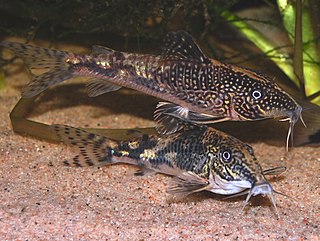
The banded corydoras or bearded catfish is a subtropical freshwater fish belonging to the subfamily Corydoradinae of the family Callichthyidae. It originates in coastal drainages in South America from Rio de Janeiro to Santa Catarina, Brazil.
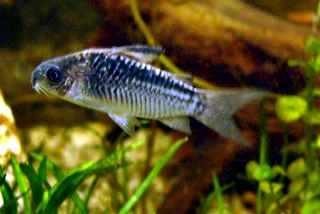
The elegant corydoras or elegant catfish is a tropical freshwater fish belonging to the subfamily Corydoradinae of the family Callichthyidae. It originates in inland waters in South America, and is found in the Upper Amazon River basin in Brazil, Colombia and Peru. The specific epithet elegans means elegant.

The hog-nosed catfish is a tropical freshwater fish belonging to the Corydoradinae sub-family of the family Callichthyidae. It is native to South America, and is found in the western Amazon basin in Ecuador and Peru. This species is traditionally placed in Brochis but the genus is a synonym of Corydoras. FishBase continues to recognize Brochis as a valid genus.
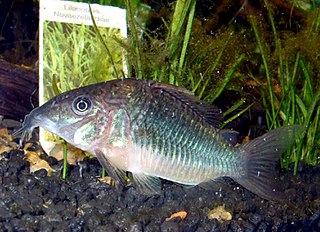
The emerald catfish is a tropical freshwater fish belonging to the Corydoradinae sub-family of the family Callichthyidae native to the Amazon Basin in South America. It has traditionally been known as Brochis splendens. The fish has appeared on a stamp in Brazil.
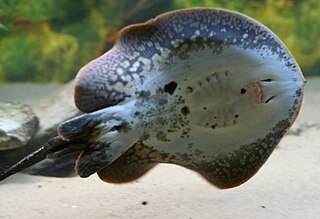
The long-tailed river stingray or antenna ray is a species of freshwater stingray in the family Potamotrygonidae. It is found in the Amazon basin in South America, ranging from Ecuador to Belém. It lives in the main channel of the Amazon River and lower parts of its major tributaries.

Pelvicachromis pulcher is a freshwater fish of the cichlid family, endemic to Nigeria and Cameroon. It is popular amongst aquarium hobbyists, and is most commonly sold under the name kribensis, although it has other common names, including various derivatives and color morphs of the kribensis: krib, common krib, red krib, super-red krib and rainbow krib, along with rainbow cichlid and purple cichlid.

Colomesus asellus, the Amazon puffer, asellus puffer, South American freshwater puffer or Peruvian puffer is a species of pufferfish confined to the Amazon, Essequibo and Orinoco basins in tropical South America. It is a popular aquarium species.
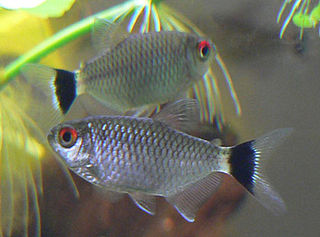
The redeye tetra, is a species of tetra from the São Francisco, upper Paraná, Paraguay and Uruguay river basins in eastern and central South America. This freshwater fish is commonly kept in aquariums and bred in large numbers at commercial facilities in Eastern Europe and Asia.

Leiarius is a genus of long-whiskered catfishes native to South America. Most of the genus' species are found in the aquarium hobby as ornamental fish.

Heterandria formosa is a species of livebearing fish within the family Poeciliidae. This is the same family that includes familiar aquarium fishes such as guppies and mollies. Heterandria formosa is not as commonly kept in aquaria as these species. Despite the common name "least killifish", it belongs to the family Poeciliidae and not to one of the killifish families. H. formosa is one of the smallest fish species; the 1991 Baensch Aquarium Atlas listed it as the 7th smallest fish in the world, and as of 2006 it remains the smallest fish species found in North America.

The green swordtail is a species of freshwater/brackish fish in family Poeciliidae of order Cyprinodontiformes. A live-bearer, it is closely related to the southern platyfish or 'platy' and can crossbreed with it. It is native to an area of North and Central America stretching from Veracruz, Mexico, to northwestern Honduras.

The ironcolor shiner is a species of freshwater ray-finned fish from the family Cyprinidae, the minnows and carps. It is a widespread species in streams and rivers in eastern North America.

Toxotes chatareus, sometimes known by the common names common archerfish, seven-spot archerfish or largescale archerfish, is a species of perciform fish in the archerfish genus Toxotes.
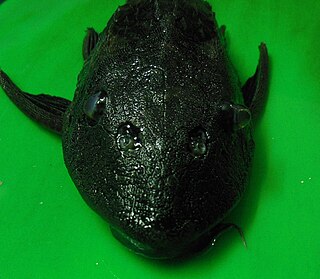
Pterygoplichthys multiradiatus is one of several tropical fish commonly known as Orinoco sailfin catfish, plecostomus. It belongs to the armored catfish family (Loricariidae). Named for its sail-like dorsal fin, the part of its scientific name multiradiatus means "many-rayed" and refers to the rays of the dorsal fin. P. multiradiatus is one of a number of species commonly referred to as the common pleco by aquarists.

The southern pygmy perch, also known as the Tasmanian pygmy perch, is a species of freshwater ray-finned fish, a temperate perch from the family Percichthyidae which is native to southeastern Australia and Tasmania.

The Cuban limia, also known as banded limia, Cuban molly, Cuban topminnow or tabai is a species of livebearing freshwater fish from the family Poeciliidae. The species is native to Cuba where it was endemic but it has been introduced to Hawaii.





















